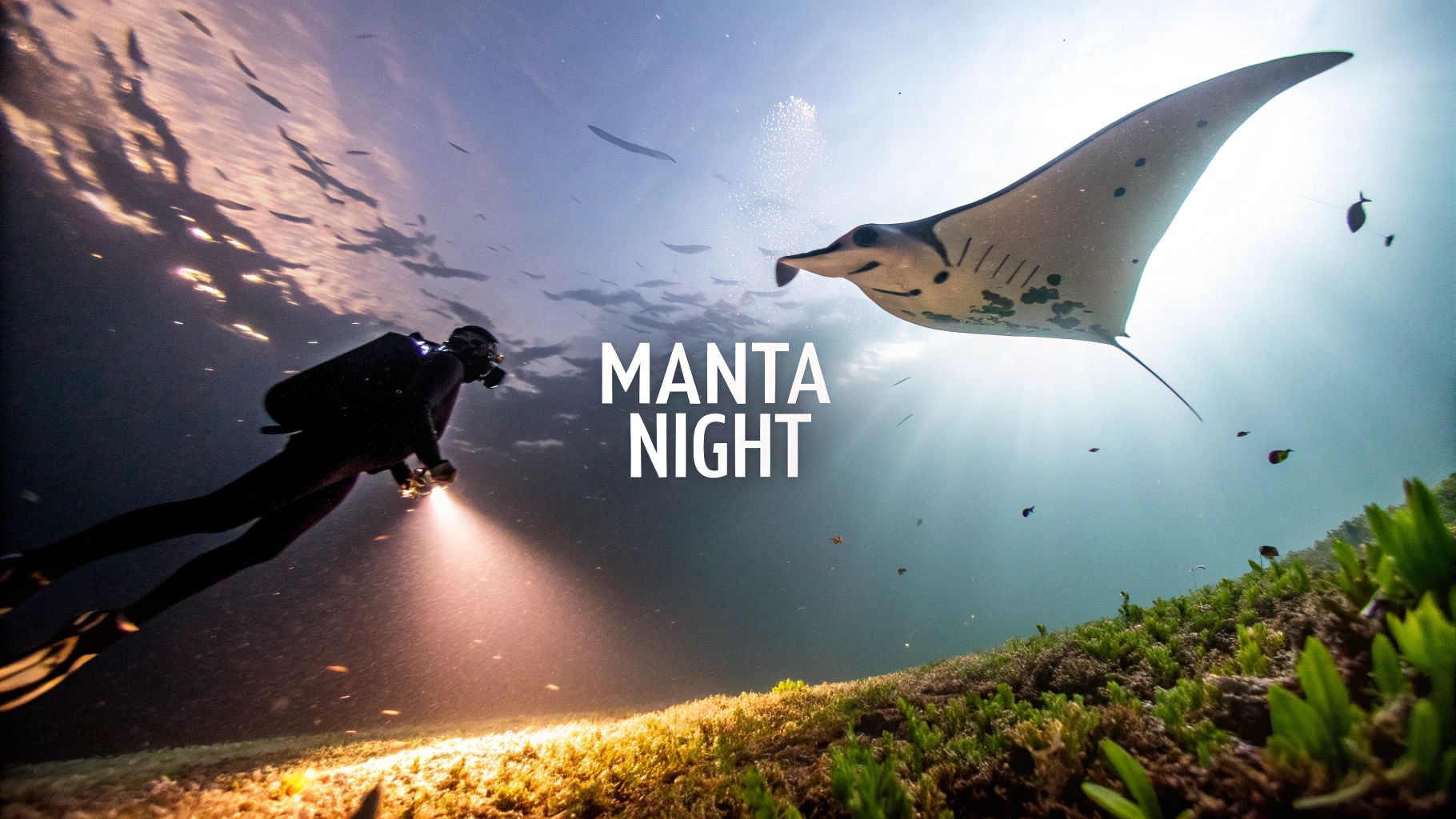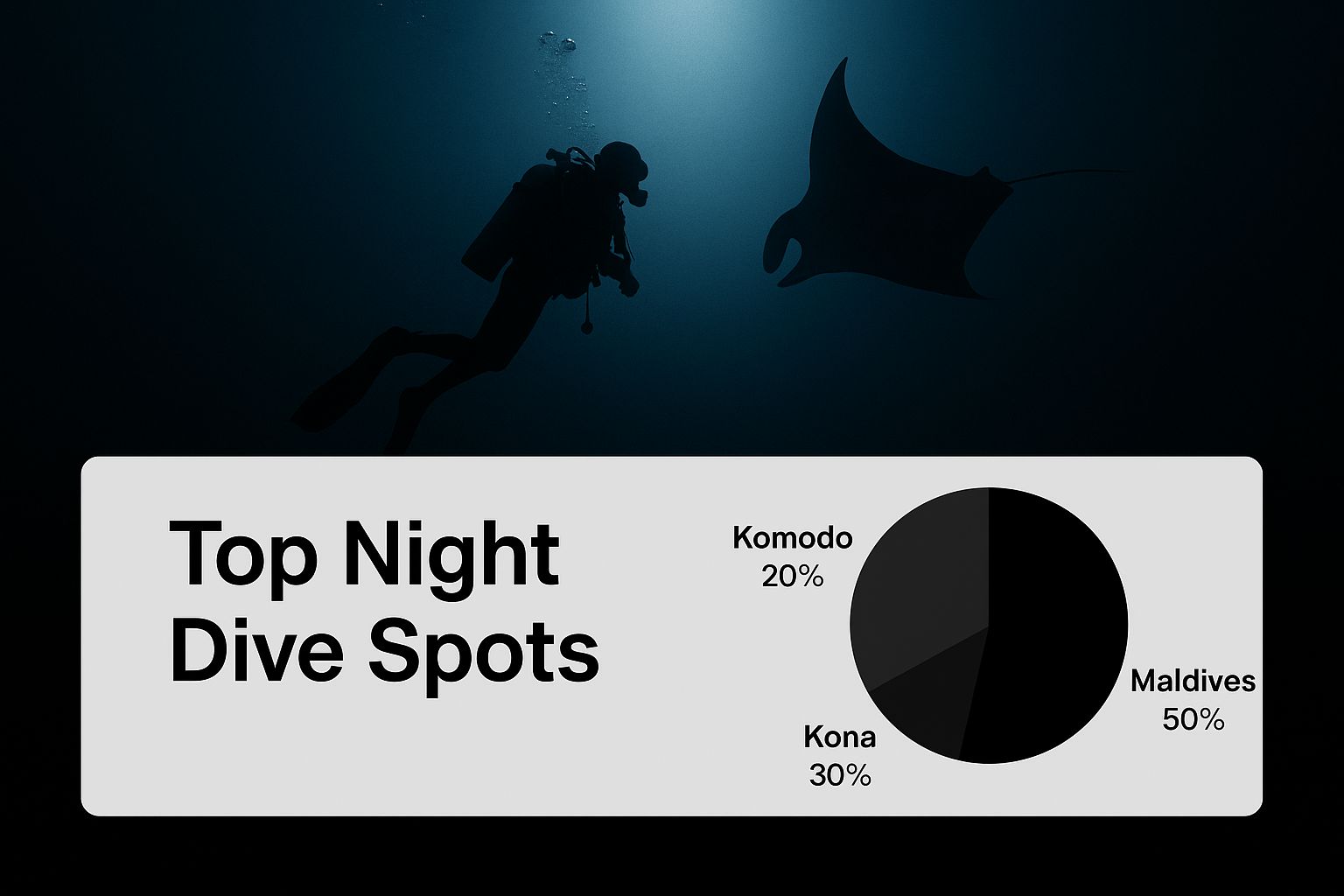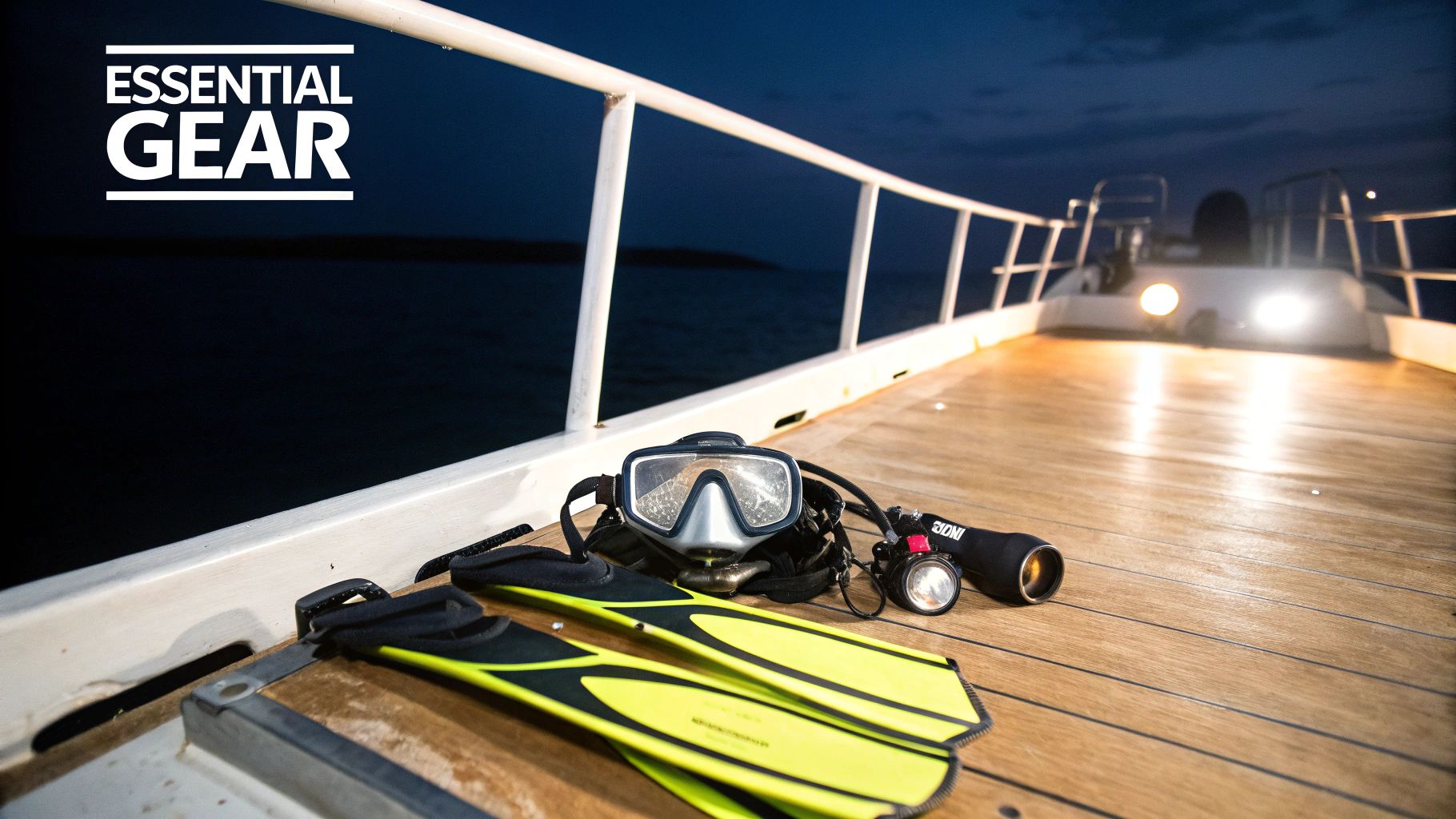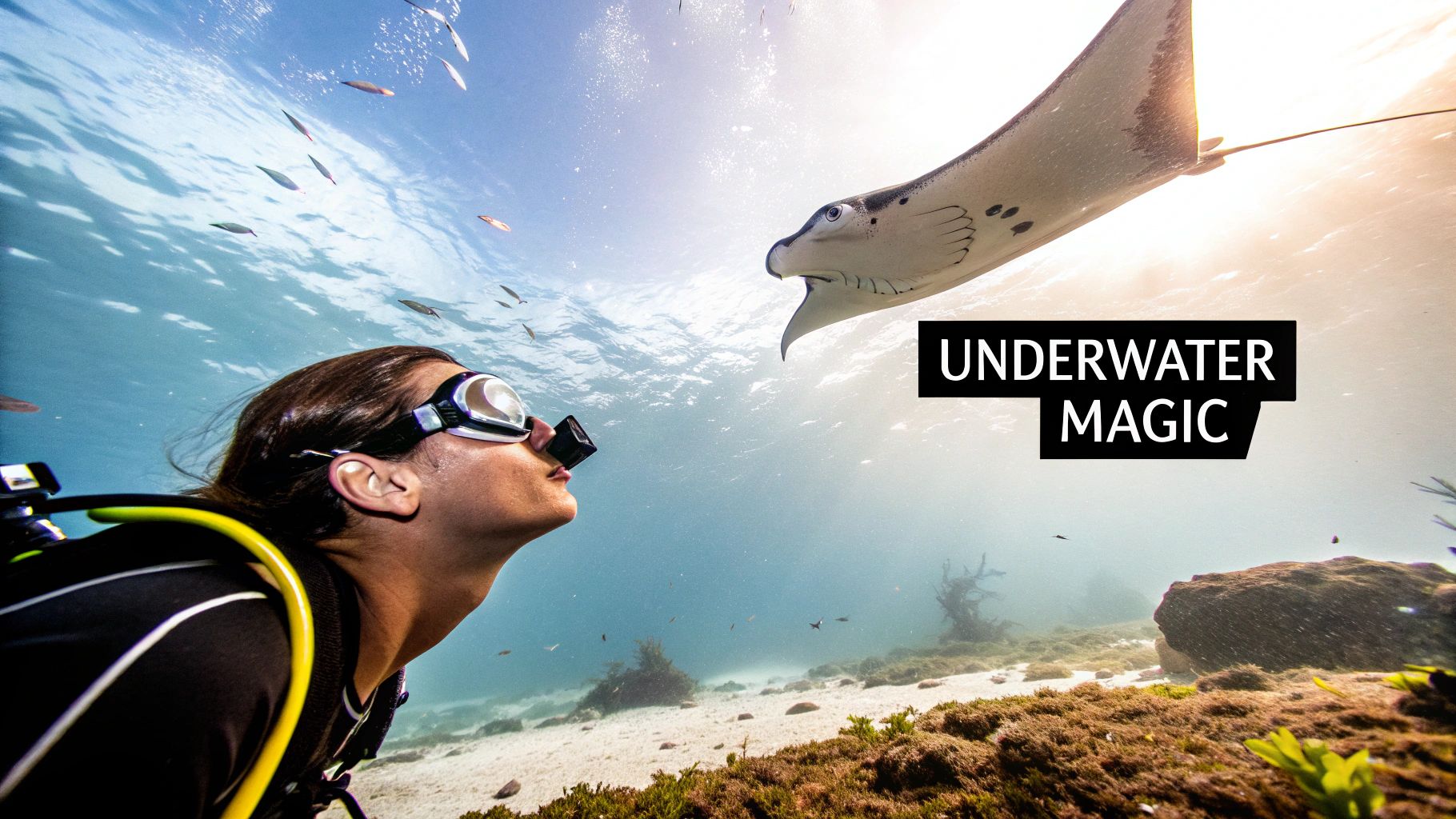Manta Ray Night Snorkel in Hawaii: An Unforgettable Experience

The Magic of Manta Ray Night Snorkeling Revealed
Manta ray night snorkeling isn't just about getting into the water; it's about entering a completely different world. This incredible experience consistently ranks as one of Hawaii's top wildlife encounters, creating unforgettable memories for those lucky enough to participate. What sets this adventure apart? It's the unique interplay of darkness, strategically placed lights, and the fascinating natural behaviors of these magnificent creatures. These gentle giants, some with wingspans exceeding 16 feet, perform an underwater ballet that mesmerizes even the most seasoned ocean lovers.
The Allure of the Night
Darkness is a key ingredient in this extraordinary experience. As the sun dips below the horizon, plankton, the microscopic organisms at the heart of the ocean's food chain, ascend toward the surface. This upward movement attracts manta rays, which feed on these tiny creatures. Tour operators skillfully use specialized lights to enhance this natural phenomenon. The lights create a "campfire effect," drawing in even more plankton, and consequently, the majestic manta rays. Curious about how to best experience this? Check out this helpful guide: How to master the manta ray night snorkel.
A Thriving Tourist Attraction
This remarkable underwater display has become incredibly popular. Manta ray night snorkeling attracts approximately 80,000 participants each year in Kona alone, showcasing the immense appeal of these nocturnal feeding gatherings. Top tour operators report remarkably high sighting success rates, typically between 85% and 90%. This success is largely due to the perfect conditions off the Kona coast, where plankton blooms and favorable water conditions combine to create an ideal manta ray feeding ground. More detailed statistics are available here. The lunar cycle also plays a role in plankton visibility, with full moon nights offering particularly good viewing opportunities.
An Unforgettable Spectacle
Picture yourself floating on the surface, peering into the illuminated depths below. Enormous shadows begin to appear, growing larger as they draw closer. Suddenly, a manta ray, propelled gracefully by its giant wings, glides just inches beneath you. The silence is profound, interrupted only by the sound of your own heartbeat and the soft whoosh of the water. It's a truly awe-inspiring experience, blurring the lines between our world and the enchanting realm of these gentle giants.
Prime Spots for Unforgettable Manta Ray Encounters
Not all manta ray encounters are created equal. Kona, Hawaii, is world-famous for its reliable manta ray sightings, but some locations are truly exceptional. Understanding what makes each spot unique will help you plan the perfect manta ray night snorkel.
Kona's Manta Ray Hotspots
-
Manta Village: Just off the coast of the Kona International Airport, Manta Village is known for its shallow, calm waters. This makes it an ideal location for beginners. The sandy bottom provides the perfect environment for plankton, which in turn attracts large numbers of manta rays.
-
Manta Heaven: A short distance from Manta Village, Manta Heaven offers a similar experience, though in slightly deeper water. This often translates to more intimate encounters with fewer crowds.
-
Garden Eel Cove (Keauhou): South of Kona, Garden Eel Cove offers a more secluded manta ray night snorkel. While less famous than Manta Village or Manta Heaven, the presence of garden eels adds a special touch to this unique site.
Choosing the Right Location
Finding the ideal spot depends on a few key factors:
-
Experience Level: Beginners might prefer the shallow, calm waters of Manta Village. More experienced snorkelers might be comfortable with the slightly deeper water at Manta Heaven or the distinctive environment of Garden Eel Cove.
-
Desired Encounter: For a more intimate experience, consider Manta Heaven or Garden Eel Cove. If you're hoping to see a large number of manta rays, Manta Village is an excellent option.
-
Accessibility: All three locations are accessible by boat, with various tour operators offering excursions. When booking your tour, be sure to inquire about accessibility options for different ages and abilities.
To help you compare the top locations, take a look at the table below:
Top Manta Ray Night Snorkel Locations in Hawaii: Comparison of the most popular manta ray viewing locations, their features, and best times to visit.
| Location | Success Rate | Best Season | Average Manta Count | Accessibility |
|---|---|---|---|---|
| Manta Village | High | Year-round, especially Summer | 10-36 | Excellent, suitable for beginners |
| Manta Heaven | High | Year-round, especially Summer | 5-20 | Good, slightly deeper water |
| Garden Eel Cove | Moderate | Year-round | 2-10 | Good, can be affected by currents |
As this table shows, each location offers a unique experience. Manta Village boasts the highest manta ray count, while Manta Heaven and Garden Eel Cove provide a chance for more personal encounters.

This infographic captures the magic of a manta ray night snorkel, showcasing a diver and a manta ray against the backdrop of the ocean at night. It's a visual reminder of the beauty and wonder that awaits at these special locations.
Seasonal Variations and Environmental Factors
The success of a manta ray night snorkel is closely tied to environmental conditions. Water temperature and plankton density significantly influence manta ray activity. During summer, warmer waters and higher plankton concentrations typically lead to more frequent sightings. Some nights, you might see as many as 36 individual manta rays at popular spots like Manta Village and Manta Heaven. This seasonal variation, affected by plankton blooms and lunar cycles, helps make the Kona Coast a great destination year-round. The effectiveness of these dives is often linked to the use of lights to attract plankton, which then draw in the manta rays. Learn more about this fascinating phenomenon here. This creates a truly unforgettable spectacle in the underwater world.
Anatomy of a Perfect Manta Ray Night Snorkel
What happens during a manta ray night snorkel? It's a meticulously planned adventure designed to optimize your encounter with these gentle giants. From the initial briefing on the beach to the incredible underwater memories, let's explore each step of this unique experience.
From Shore to Sea: The Initial Stages
Your adventure begins with a comprehensive briefing on land. Knowledgeable guides will explain the process, including safety protocols, snorkeling tips, and appropriate manta ray etiquette. This is your opportunity to ask questions and address any concerns about water temperature, nighttime visibility, or physical demands. This important first step sets the stage for a safe and enjoyable experience, building excitement for the wonder to come.
The Campfire Effect: Illuminating the Depths
Once in the water, you'll typically hold onto a specialized floatation device equipped with bright lights. These lights are essential for attracting the manta rays. They illuminate the water, attracting plankton, the manta rays' main food source. This creates what's known as the "campfire effect," drawing in large quantities of plankton and, as a result, the majestic mantas themselves.
A Sensory Symphony: Beyond What Cameras Capture
As darkness falls, a sense of anticipation hangs in the air. Massive shadows then begin to appear from the deep, growing larger as they draw near. The first glimpse of a manta ray gliding effortlessly through the water is often described as exhilarating. But the experience is more than just visual. The deep silence, interrupted only by your own heartbeat and the subtle sounds of the ocean, adds another dimension to the experience. It's a multi-sensory experience impossible to fully capture on film.
Manta Ray Ballet: Observing Natural Behaviors
Manta rays are filter feeders, consuming large amounts of plankton. During your night snorkel, you'll likely witness their elegant feeding techniques. Some mantas perform "barrel rolls," flipping through the water to maximize plankton intake. Others perform "cyclone feeding," creating a captivating spiral as they ascend, pulling plankton into their mouths. These natural behaviors, illuminated by the specialized lights, create an unforgettable spectacle.

Group Dynamics and Operator Variations
While the core elements of a manta ray night snorkel are generally the same, individual tour operators may organize their experiences slightly differently. Group sizes, boat types, and the specific location can all influence the overall feel of the encounter. Some operators focus on smaller, more intimate groups, while others cater to larger groups. Those interested in photography should inquire about specific operator policies regarding underwater cameras and lighting. Be sure to select a tour that fits your preferences.
Addressing Common Concerns
Many first-time manta ray night snorkelers have questions about water temperature, visibility, and physical requirements. The water temperature in Kona is usually pleasant, but a thin wetsuit or rash guard offers additional warmth. Visibility is surprisingly good due to the specialized lighting. The snorkeling itself requires minimal physical effort, making it suitable for people of various ages and fitness levels. It's always recommended to communicate any physical limitations or concerns to your tour operator in advance. They can provide assistance and ensure your comfort and safety. With a little preparation and the right mindset, your manta ray night snorkel will be a truly memorable adventure.
Conservation and Connection: The Ethics of Manta Encounters
The incredible opportunity to snorkel with manta rays at night carries a significant responsibility. Finding a balance between the thrill of these tourist experiences and the protection of these vulnerable marine animals is crucial. Responsible operators play a vital role in both manta ray research and their ongoing conservation.
Respectful Interaction Guidelines
Decades of observation and research have resulted in specific interaction guidelines. These guidelines help ensure that manta ray night snorkeling remains a sustainable practice.
- Proper Positioning: Never attempt to touch or ride a manta ray. Maintain a respectful distance, allowing the manta ray to control the interaction.
- Light Management: While lights are necessary to attract plankton, excessive or poorly aimed lighting can disturb the manta rays. Always follow your guide's instructions regarding light use.
- Respectful Distancing: Avoid crowding the manta rays or obstructing their path. Give them plenty of space to move and feed naturally.
These practices are essential for minimizing our impact on these gentle giants and their delicate environment. Manta ray night snorkeling isn't just a popular activity; it also has a measurable environmental impact. A survey of 444 participants in a similar environment found that 82% felt crowded by other snorkelers, 78% by boats, and 69% by scuba divers. This underscores the need for sustainable management practices for these tours, as high participation rates can negatively influence the manta rays' habitat and behavior. More detailed statistics are available here. Responsible tourism is key to safeguarding the manta ray population and the broader ecosystem. Ongoing monitoring and data collection, like the cataloging of over 300 individual manta rays, is vital for understanding and effectively managing these interactions.
Global Threats and the Role of Tourism
Manta rays encounter numerous threats globally, from targeted fishing for their gill plates to the increasing effects of climate change. Responsible tourism, however, can play a positive role in their conservation. This happens through raising public awareness about the beauty and importance of these animals, and by contributing to vital research funding.
Identifying Responsible Operators
Choosing a responsible operator is paramount for an ethical manta ray night snorkeling experience. When selecting a tour, look for operators who:
- Hold the necessary certifications and permits.
- Adhere to the established interaction guidelines.
- Actively participate in conservation initiatives.
- Partner with reputable marine research organizations.
By supporting responsible operators, you can ensure your manta ray night snorkel contributes to the long-term well-being and survival of these magnificent creatures, guaranteeing these unique encounters remain possible for future generations. This approach to tourism emphasizes enjoyment coupled with respect for the marine environment.
Insider Secrets for Extraordinary Manta Ray Encounters
Going beyond the basics can transform a good manta ray night snorkel into a truly unforgettable experience. We've gathered insights from experienced guides, underwater photographers, and frequent snorkelers to help you maximize your manta ray encounter.
Strategic Booking for Optimal Viewing
Timing is everything when it comes to manta ray night snorkeling. Strategic booking can significantly improve your chances of an amazing encounter.
- Moon Phases: Plan your snorkel around a new moon. The darker the night, the more visible the plankton, which attracts the manta rays.
- Seasonal Considerations: While manta rays can be seen year-round in Kona, the summer months typically offer warmer waters and higher plankton concentrations. This often leads to more frequent sightings.
- Days of the Week: Consider snorkeling on a weekday. Weekdays often have fewer crowds than weekends, allowing for a more personal and intimate experience with these gentle giants.
You can learn more about planning your trip here: How to master the manta ray night snorkel experience.
Practical Preparation for a Smooth Experience
Proper preparation enhances comfort and maximizes enjoyment during your night snorkel. A few simple steps can make a world of difference.
- Sensory Adaptation: Before entering the water, spend a few minutes adjusting to the darkness. This allows your eyes to adapt, improving your night vision and making it easier to see the manta rays.
- Anti-Fogging Techniques: Apply anti-fog solution or a small amount of saliva to the inside of your mask. This will prevent fogging, a common issue in cooler night air.
- Thermal Rash Guards: Consider wearing a thermal rash guard under your wetsuit or on its own if the water is warm enough. They provide warmth and flexibility, important for comfortable movement in the water.
These small preparations can greatly enhance your overall enjoyment.
Managing Anxiety in the Night Water
For some, entering the water at night can be a little unnerving. Here are some techniques to ease any anxiety:
- Controlled Breathing: Practice deep, slow breaths to calm your nerves and relax your body.
- Focus on the Light: Concentrate on the lights from the floatation devices and the bioluminescent plankton. This can help distract you from any anxious thoughts and enhance the magical atmosphere.
- Stay Close to the Group: The presence of others can provide a sense of security and reassurance.
With a little mental preparation, you can fully appreciate the magic of this unique experience. For other unique adventures, this guide offers helpful tips on flying drone in national parks.
Photography Tips for Capturing the Magic
Capturing the beauty of manta rays at night presents unique photographic challenges but is incredibly rewarding.
- Camera Settings: Use a high ISO setting, a wide aperture, and a slow shutter speed to capture as much light as possible. Experiment with your camera beforehand to find the optimal settings.
- Positioning Strategies: Position yourself slightly below the manta ray to capture its graceful silhouette against the illuminated plankton. This offers a dramatic and captivating perspective.
- Ethical Considerations: Never use flash photography, as it can startle and disorient the manta rays. Respect their natural behavior and prioritize their well-being.
These guidelines ensure you can document your experience responsibly. Patience and a keen eye for detail are essential for capturing breathtaking images.
Before you embark on your manta ray adventure, take a look at this helpful checklist:
The following table outlines essential items to bring and pre-trip actions to ensure a smooth and memorable experience.
Manta Ray Night Snorkel Preparation Checklist
Essential items to bring and actions to take before your manta ray night snorkel adventure
| Category | Essential Items | Optional Items | Pre-Trip Preparation |
|---|---|---|---|
| Gear | Snorkel gear (mask, snorkel, fins), Wetsuit or thermal rash guard | Underwater camera, Waterproof bag | Check all equipment for proper function |
| Personal Items | Towel, Sunscreen (applied before arrival), Seasickness medication (if needed) | Hat, Sunglasses | Review tour operator safety guidelines |
| Photography | Camera with waterproof housing, Extra batteries and memory cards | Red filter for underwater photography | Practice camera settings in low-light conditions |
| Mental Preparation | Positive attitude, Open mind | Knowledge of manta ray behavior | Visualize a successful and enjoyable experience |
By following this checklist, you can ensure you are well-prepared for your manta ray night snorkel.

The Science Behind the Magic: Understanding Manta Behavior
Enhancing your manta ray night snorkel experience starts with a deeper understanding of these captivating creatures. Drawing on insights from marine biologists and manta ray researchers, we can delve into the evolutionary wonders that make these animals so compelling. Want to learn even more about these gentle giants? Check out our article on why manta rays are so cool.
Feeding Patterns: A Ballet of Plankton Consumption
Manta rays are filter feeders, meaning their diet consists primarily of plankton. Over time, they've developed specialized feeding techniques that maximize their intake of these tiny organisms.
- Cyclone Feeding: This breathtaking spectacle involves multiple manta rays creating a swirling vortex. This vortex concentrates plankton, effectively funneling it directly into their mouths.
- Somersault Feeding: Here, a single manta ray executes repeated backflips, or somersaults, trapping plankton within its cephalic fins.
- Chain Feeding: This technique involves manta rays lining up, one after the other, to filter plankton in a coordinated, remarkably efficient manner.
These feeding patterns are visually stunning. They also showcase the impressive efficiency with which manta rays have adapted to their environment. Their cephalic fins, flexible extensions of their mouths, serve as natural funnels, guiding plankton into their mouths with incredible precision.
Manta Ray Intelligence: Beyond the Surface
Manta rays are more than just their impressive size and graceful movements. They also possess surprising intelligence. Research indicates they may exhibit:
- Self-Awareness: Studies suggest manta rays may recognize themselves in mirrors, a potential indicator of higher cognitive function.
- Complex Social Interactions: Manta rays display intricate social interactions, engaging in playful behavior and even what appears to be cooperative feeding.
- Problem-Solving Abilities: There's evidence suggesting manta rays have the ability to solve simple puzzles, further showcasing their cognitive capabilities.
These findings shed light on the complex mental lives of manta rays, elevating our perception of them from simple filter feeders to intricate, intelligent beings. Looking for more fascinating deep dives? Explore historical artifacts and learn about identifying vintage furniture. It's another world of discovery!
Identification and Tracking: Unique Markings
Each manta ray boasts unique markings on its ventral side (belly). These spot patterns, much like fingerprints, allow researchers to identify and track individual manta rays over extended periods. This tracking yields essential data on population dynamics, migration patterns, and individual life histories. By learning to recognize these markings yourself, you can develop a deeper appreciation for the distinct individuality of each manta ray you encounter during your snorkel.
Conservation Status and Challenges
Understanding the reproduction, migration, and conservation status of manta rays adds an important dimension to your night snorkel experience. Manta rays face a number of challenges, including:
- Slow Reproduction: Manta rays have a slow reproductive rate, typically giving birth to only one or two pups every few years. This makes them particularly vulnerable to population decline.
- Habitat Loss and Degradation: Coastal development and pollution pose a serious threat to manta ray habitats, negatively impacting their feeding grounds and crucial breeding areas.
- Bycatch: Manta rays are sometimes unintentionally caught in fishing nets, a significant danger to their survival.
By understanding these challenges, you can become a more informed and responsible participant in manta ray tourism, contributing to their long-term preservation.
Ready for an unforgettable encounter? Book your manta ray night snorkeling adventure with Kona Snorkel Trips today! Book Now!
